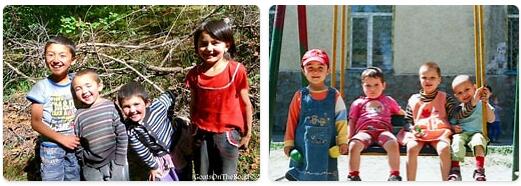Yearbook 2016
Kyrgyzstan. The current population of Kyrgyzstan is 6,524,206. Reduced production of gold and silver put severe pressure on the country’s economy. In January, exports fell by about 40% and GDP fell sharply. Kyrgyzstan was also severely affected by the recession of the Russian Federation and China’s economic slowdown.

The government was in long-standing conflict with Canada-based Centerra Gold, the owner of the largest gold mine Kumtor, on the distribution of profits. The Eco Crime Authority raided Centerra on suspicion of financial crime, and the company was also fined for environmental damage. It was the first of several lawsuits on large sums. In June, President Almazbek Atambayev ordered state prosecutors to investigate the legality of the agreements with Centerra. The company, which is the country’s largest investor and taxpayer, said its business was threatened and turned to the international arbitration tribunal in Stockholm to try to resolve the disputes with the government.
President Atambayev accused his political opponents of trying to destabilize the country by escalating a border conflict with Uzbekistan. He also claimed that the security service had evidence that opposition politicians intended to oust him by turning up the crowds. Two accused politicians responded that the security service’s audio recordings were false.
In April, Prime Minister Temir Sarijev resigned after a parliamentary commission accused the government of corruption in procurement for a road construction. Sariyev said he was innocent, claiming that political rivals were trying to hurt the government through rumors.
As new Prime Minister, Parliament elected President Atambayev’s ally Sooronbay Jeenbekov. He was nominated by Atambayev’s party of the Social Democrats, the largest in the four-party government.
In August, 17 Kyrgyz guest workers were killed in a fire in Moscow. About half a million Kyrgyz people work in the Russian Federation, often in poor environments and with poor fire safety.
In August, China’s embassy in Bishkek was attacked by a suicide bomber, who himself lost his life and injured three security guards. Suspicions were directed at Uighur separatists from neighboring Chinese Xinjiang.
According to thereligionfaqs, President Atambayev of Kyrgyzstan ran a referendum during the year on amendments to the constitution that strengthened the prime minister’s role. The opposition accused Atambayev of planning to take over that role himself when he resigns as president in 2017.
In the midst of the conflict, Atambayev was removed from the country when on his way to the UN in New York landed in Turkey and then flown to a Moscow hospital, reportedly with heart problems. Rumors said that Atambayev was deliberately staying away if he lost the power struggle at home.
When Atambayev returned, the government cracked down on the draft constitutional amendment. The Socialist Party of Fathers thought that the proposal would give the head of government too much power. Atambayev’s Social Democrats left the coalition, and Prime Minister Sooronbay Jeenbekov resigned. The Social Democrats, Kyrgyzstan Party and Unity formed a new majority government, where Jeenbekov again became head of government.
In December, the planned referendum said yes to the constitutional changes that give the prime minister extended powers.
Kyrgyzstan
Soviet socialist republic since 1936, Kyrgyzstan is today an independent republic (Republic of Kyrgyzstan), within the Commonwealth of Independent States (CIS), born from the dissolution of the USSR. The new town covers an area of 198,500 km 2 and, at the 1989 census, had 4,291,000 residents. (of which 52.4% Kyrgyz, 21.5% Russians, 12.9% Uzbeks, 2.5% Ukrainians, 2.4% Germans and 1.6% Tatars). The population, according to an estimate of 1991, was equal to 4,222,000 residents, with a density of 21 residents / km 2. The capital, Biškek (ancient name of the city, restored in 1991 in place of Frunze), had 626,900 residents. in 1990, of which nearly two thirds were Russian (the largest percentage among Eurasian cities). Other cities are: Oš (213,000 residents), Džalal-Abad (74,000 residents), Prževalsk (62,000 residents). In September 1989, Kyrgyz replaced Russian as the official language.
The town’s economy is based on agriculture and livestock.
In 1990 the cultivated area was equal to 16.1 million ha, of which 974,000 were irrigated, and the degree of mechanization was quite high; sugar beets, cereals, tobacco and fruit are the main products, while silkworm and beekeeping are two specialized branches. Livestock farming is the other important element in the Kyrgyz economy: there are especially cattle (1.2 million head in 1990), sheep and goats (10.4 million) and horses (the famous Kyrgyz horses, of small stature and extraordinary strength). The yak, a large hairy bovine used as a pack animal, for meat and milk, is raised at high altitudes, where common cattle cannot resist.
The availability of abundant electricity from water favors an ever greater industrialization of the country, which has over 500 large industrial plants. The food (sugar mills), textile (cotton mills, silk mills), metallurgical, tobacco and cement sectors are mainly active. In Kyrgyzstan there are also important deposits of antimony, mercury, uranium and coal.
The overall development of the railway network is 370 km; the road network measures 28,400 km. A road tunnel is under construction, which will connect the two cities of Bishkek and Oš through the Tien Shan mountains. The capital has an international airport.